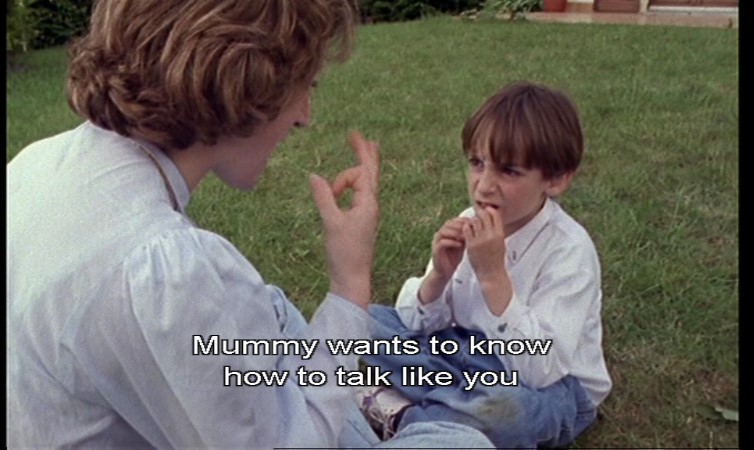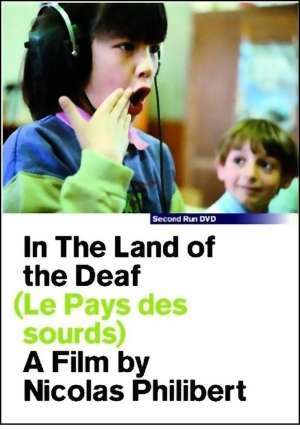From the Chicago Reader (August 5, 1994); this was reprinted with the DVD of this film released in the U.K. by Second Run Features (see below). — J.R.
*** IN THE LAND OF THE DEAF
(A must-see)
Directed by Nicolas Philibert.
Nicolas Philibert’s beautiful, illuminating, and energizing documentary, Le pays des sourds (“In the Land of the Deaf”), playing Saturdays and Sundays in August at the Film Center, implicitly reflects on three different kinds of language: (1) the different languages spoken in movies, (2) the so-called language of cinema, and (3) sign language, specifically the language of the deaf.
(1) Language in film. I never attended a film school, but during the five years I lived in Paris, from 1969 to 1974, I was unofficially attending something very close to one several days a week — the Cinematheque Francaise, which was then operated by its eccentric, visionary main founder, Henri Langlois (1914-1977). The Cinematheque had two screening facilities that showed together seven or eight films daily, each for a nominal price; if you had a student card, each was less than a dollar. These were films from all over the world, and Langlois was a purist: silent films were almost never shown with musical accompaniment, and little effort was made to show silent or sound films with subtitles that the audience could understand. For Langlois, the essence of cinema was the image, and he saw the Cinematheque as a kind of utopian Tower of Babel where images carried the essential messages. As if to prove his point, he frequently programmed the only feature ever made in Esperanto — produced, I believe, during the 50s — which virtually no one in the audience could understand.
The obvious drawback of the Cinematheque was that one often saw movies without fully understanding the dialogue or plot; the equally obvious advantage was that one saw more world cinema than one could have seen anywhere else in the world, and one learned, often by necessity, to glean meanings not contained in the dialogue or intertitles. (Since then I’ve had opportunities to see some of the masterpieces I first encountered at the Cinematheque with subtitles I could understand, and thereby have caught up with certain lost meanings. But in many other cases those old masterpieces still haven’t been translated, which means that a major part of film history is unavailable to most American viewers.)
(2) “Language” of film. What’s usually meant by “the language of cinema” is the set of visual and aural conventions involving editing, framing, mise en scene, sound recording, and sound mixing to which all moviegoers respond, though few apart from some academics have bothered to spell them out. Whether these conventions and the messages they send constitute a language is debatable, though there was an entire cottage industry of film theory during the 70s predicated on that assumption. The intricate rules of conventional editing are a good example of what I’m talking about: very few viewers are capable of defining them but nearly everyone responds to them, just as native speakers of a language follow the rules of grammar even if they don’t consciously know what they are. This makes editing at least resemble language.
(3) Sign language (or Sign). It seems that the usual response of someone who hears a foreign language is to assume, often unconsciously, that it’s a failed attempt at the language one already knows — an assumption subtitling helps to encourage by supposedly providing the “real” meaning. Similarly, unconventional kinds of film editing informed by sophisticated avant-garde strategies might be misread as failed attempts to follow conventions rather than as successful efforts to pursue other ends.
Similarly, when most of us first encounter Sign — of which there’s a great deal in In the Land of the Deaf, along with English subtitles “translating” it — our likely first response is to “read” it as if it were a form of pantomime. But according to Oliver Sacks in his recent book Seeing Voices, this reflects a misconception: “We see . . . in Sign, at every level — lexical, grammatical, syntactic — a linguistic use of space: a use that is amazingly complex, for much of what occurs linearly, sequentially, temporally in speech, becomes simultaneous, concurrent, multileveled in Sign. The “surface’ of Sign may appear simple to the eye, like that of gesture or mime, but one soon finds that this is an illusion, and what looks so simple is extraordinarily complex and consists of innumerable spatial patterns nested, three-dimensionally, in each other.”

This observation can be adapted to the so-called language of cinema: young viewers often maintain that silent films are unwatchable today, that they’re crude, primitive approximations of what sound movies do much better. But this rejection is of course partially a learned response rather than an innate reaction: the same audience never seems to mind the visual corruptions and limitations of TV and video. One might come closer to the truth by reversing the paradigm: isolating certain silent masterpieces and assuming that current popular sound movies are crude attempts to approximate their expressiveness. Compare Tom Hanks in Forrest Gump or Zbigniew Zamachowski in White with any of the silent slapstick stars these sad sacks are directly or indirectly patterned after — Chaplin, Keaton, Laurel, Langdon, Lloyd — and the difference is like that between an able conservatory pupil playing an exercise and a virtuoso musician performing in concert.

Better yet, compare the expressiveness of Arnold Schwarzenegger in True Lies with that of any of the people speaking Sign in Philibert’s documentary, children or adults, male or female, and the differences become astronomical. Despite the benefit of spoken language, Schwarzenegger’s palette is so limited that the only “emotions” he registers are actually parodies of emotions, which is why he usually seems miscast as anything but a robot. By contrast the people signing in Philibert’s film — and these are almost the only people we see — use their faces and bodies like agile paintbrushes, speaking to us and to each other with all the colors imaginable, vibrantly and directly. (As Jean Gremion writes in The Planet of the Deaf, “In sign language, the smallest bat of an eyelash can become an element of syntax.”)
Even more remarkable, the fact that most of us in the audience understand English but not Sign plays a secondary role. English subtitles translate for us, but one discovers early on that, like subtitles translating spoken languages, the translation is only a partial, reductive version of what’s being expressed. Even if one ignores the subtitles, the range of emotions — from grief to joy, from anger to affection, from enthusiasm to indifference — is so great, and the power behind each of them so immediate, that we often feel blown away by the sheer force of the subjects’ personalities. The particulars conveyed in the subtitles are helpful and important, but as the film progresses they begin to seem more and more like footnotes to large-scale texts that only Sign can convey.
To quote Sacks again, “One has only to watch two people signing to see that signing has a playful quality, a style, quite different from that of speech. Signers tend to improvise, to play with signs, to bring all their humor, their imaginativeness, their personality, into their signing, so that signing is not just the manipulation of symbols according to grammatical rules, but, irreducibly, the voice of the signer–a voice given special force, because it utters itself, so immediately, with the body. One can have or imagine disembodied speech, but one cannot have disembodied Sign. The body and soul of the signer, his unique human identity, are continually expressed in the act of signing.”
One might also regard the subtitles in Philibert’s film the way one regards librettos, as texts without the benefit of either music or performance, which is what the deaf people are supplying. One suspects that Philibert has this analogy in mind, because he begins the film with the camera pulling back from two women and two men performing Sign together to sheet music on music stands, and the musical effect of their individual and collective gestures — their passages in unison and their interactive duets — is immediately obvious.
The relationships between Sign and cinema are obviously deep and complex; significantly, the film’s first Sign monologue reveals a mute subject’s lifelong fascination with movies. But this doesn’t mean that Sign and cinema are automatically interchangeable. The aim and achievement of Philibert’s film is to plunge us as completely as possible into the world of communication between deaf people, and in order to do this he’s had to rethink, to some extent, the language of cinema – -the conventions of framing, editing, and even sound recording. In a fascinating article for the French film magazine Trafic, Philibert has described in detail how conventional documentary filming methods proved inadequate for capturing the subtle interactions between deaf people. (For example, “Although sound operates in 360 degrees, in the realm of the deaf the voice-off does not exist: out of sight, communication is not possible; outside the frame, not even a hello.”) In the same article he explains why making a purely silent film would not have accurately represented the world of the deaf — which, “contrary to what is believed, is not pure silence. Confused, faraway murmurs, diffuse noises: even for the so-called “stone’ deaf, it is not nothingness.” Philibert manipulates his own sound track at times in order to suggest some of that subjective experience, most noticeably at the very end of the film, and some of the Sign monologues deal with certain aspects of the experience as well. (A mute born into a nearly all deaf family describes the initial experience of using a hearing aid as extremely unpleasant: “The sound of chairs — it was awful.”)
But the principal bounty of this film is the relatively unmediated and magnificent spectacle of Sign itself, performed by numerous individuals for whom “acting” and “being” appear to be indissoluble and indistinguishable. These extraordinary people include some of the best child “performers” I’ve seen since the films of Truffaut, as well as a wondrous, comical Sign teacher whose everyday utterances automatically place him in the pantheon of character actors occupied by such figures as Walter Brennan, Michel Simon, and William Demarest. I’m tempted to say that I haven’t seen such emotional, multifaceted physical expressiveness in so many people since the golden age of silent movies; but alas, among contemporary moviegoers that no longer serves as a recommendation. So let me put it differently: if you want to see and hear people who will make you feel more alive, the likes of whom you won’t come close to finding in any commercial release now playing, make your way to the Film Center and check this movie out.


